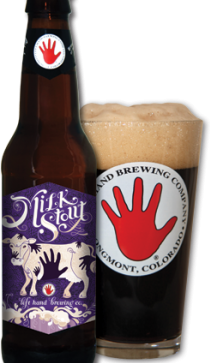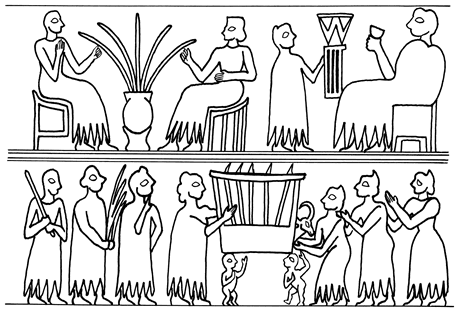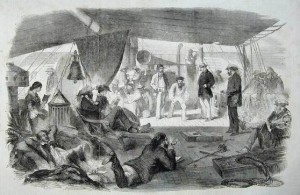
– Beer Review – Left Handed Brewing Co: Milk Stout / By DJ Adams
Sometimes you’re not in the mood for what everyone else is having. That’s the tagline of this Longmount, Colorado brewer Left Hand Brewing Co’s Twitter presence. As I approach the bar at Port Street Beer House and observe the orders for a seemingly endless collection of beers, one bottle calls out to me from the fridge. Milk Stout. Exactly what I’m looking for. This beer’s reputation precedes it; awards galore already won, most recently Gold in the European Beer Star Competition.
Sunlight streams through the windows on this cold, crisp autumn day as I reverently carry the bottle and a stemmed glass to the table. This is not your father’s stout. No sense of vast volumes of heavy blackness tinged with bitterness here, thank you very much. This is a full-bodied sweet stout, an English style beer from the late 19th century. Espresso coloured, with coffee traces and slight vanilla notes, this is an incredibly velvety smooth experience from start to finish. Any hints of bitterness are more than balanced from the inclusion of milk sugar, which is defined as “a sugar comprising one glucose molecule linked to a galactose molecule”. Galactose? Space milk? All I know is that the inclusion of milk sugar into the brew has had a fabulous effect. Sweetness and chocolate overtones make this a very enjoyable experience. Normally at this stage in the review I have some beer left in the glass, but the glass and bottle are both empty already.
Left Hand Brewing Co’s philosophy is about balance. It’s fair to say that they’ve achieved a great balance between traditional style and modern interpretation, between the Magnum and US Golding Hops, the myriad malts (from Crystal to Flaked Barley and Chocolate) and the milk sugar sweetness, and between the relatively high ABV content and inherent drinkability. Next time you’re stuck or spoiled for choice, go for something different. Take a chance on this Milk Stout, and you’ll be far from disappointed.
Brewer: Left Hand Brewing Co
Brew: Milk Stout
Style: Sweet Stout
ABV: 6.0%
http://www.lefthandbrewing.com/
Words by: DJ Adams – http://www.pipetree.com/qmacro/

– A Shot In The Dark / by Jay Krause
Autumn is in the air. The cool mornings of summer are giving way to the crisp early hours of my favourite season. The evenings are getting shorter and the cars are switching on their headlights sooner. The midday sun is present but weaker, getting further away in accordance to our orbit. In the early evening, bars in pubs are becoming places of sanctuary and the pumps are seeing the introduction of more and more seasonal dark beers.
This is all very welcome to me, and one of the reasons autumn is my favourite season. I absolutely love dark beer, in all its forms. Stouts, Porters, Dark Milds, Schwartzbiers, Dunkels, Black IPAs, and every other type of beer which absorbs light – I love them. (more…)

– Women and Beer / By Alex Humphreys & Rosie Setterfield-Price
In the beer world it seems to be a mans domain. Many women who have an input are easily dismissed or their efforts go unrecognised, this is the result of our cultural and industrial development over time and seems ignorant to the industry’s foundation and past.
Traditionally, it was the woman’s role, as a brewster, to brew beer for the household and certain laws state that the tools to brew were solely the woman’s property. Through various historical and sociological developments this is no longer the case so much so that the opposite is almost true. In Medieval times monastries started to brew beer on a larger scale for passing travellers, when the industrial revolution came about it transferred brewing from the home to the marketplace, resulting in the decline of women brewing at home. Men claimed the local taverns and women drank less beer. There was an increase in male brewers and it has been so ever since. Obviously female brewers are active today yet they don’t get the recognition of their male counter parts, this industrialisation of the beer industry does not adequately explain why most women, when choosing a beverage feel a distance between themselves and beer.
Women’s roles in today’s beer industry tend to be stereotyped with the dispense of beer, from female bar staff serving beverages to the female figure being the main image on a beer’s pump clip in the hope that it will sell more. Beer marketing as such does tend to highlight men as the target audience, this alone does not seem an ample explanation for the high numbers of women who don’t appear comfortable both drinking and sampling a wider range of beers. It’s time that the culturally accepted and prescribed gender roles regarding women and beer were more actively challenged.
At Port Street Beer House we try to broaden everyones view on the beer industry, with varying degrees of success. Whilst it is a refreshing change to serve male customers a half of fruit beer, this is a more common occurrence than serving female customers a pint of porter or stout for no discernable reason other than a willingness to experiment with different beer styles and flavours. All our staff have a keen personal interest in beer and have all been trained to a equal level. We are ready to help you with your beery needs.
This week at PSBH we are hosting ‘ladies week’. With a selection of cask ales brewed by women. Come along and build a beer bridge.
– India Pale Ale / By John Clarke

India Pale Ale. Three short words and so much controversy. What’s all the fuss about? In a word, “authenticity”. From time to time the beer blogosphere, newsgroups and forums will be racked with argument about what makes an “authentic” IPA. So, what is an authentic IPA – and more to the point does it matter?
As a style, IPA has been around for over 200 years now. Books have been written about its origins but suffice it to say this was a beer originally designed to survive a six month sea voyage from the UK to the British colonies in India. It is one of this country’s greatest and enduring contributions to the world of beer and is now brewed across the globe in all manner of variations. Which brings us back to “authenticity”. (more…)